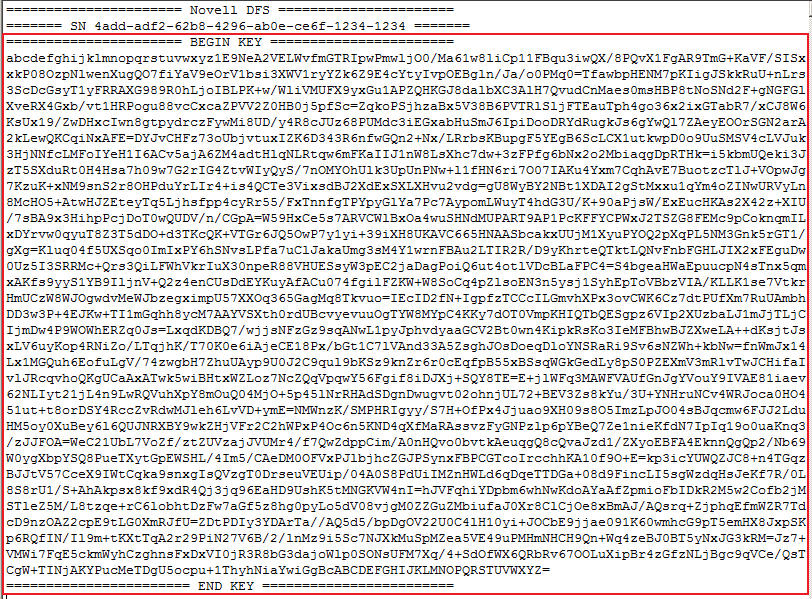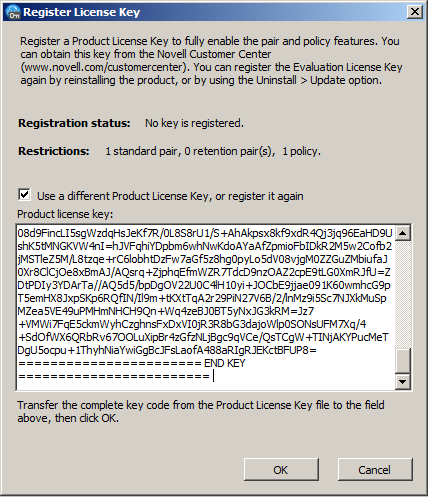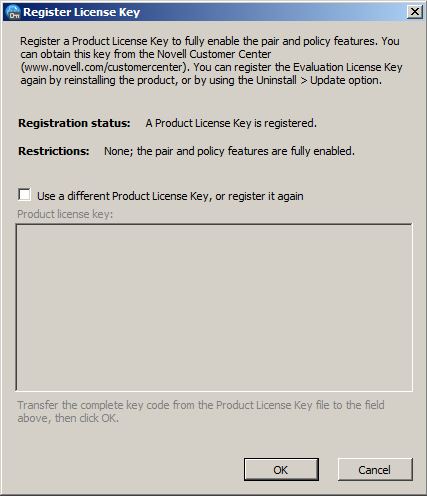6.2 Registering the License Key
Registering a Dynamic File Services License Key allows you to use all of the product features. A user with Administrator privileges must register a license key on each computer where the Service component is installed.
A License Key is not required to evaluate Dynamic File Services. Most product features will function normally. However, you are restricted to using one pair and one policy at a time until a License Key is registered on the system.
You can enter a License Key at any time after you install Dynamic File Services. After a successful key registration, all features of the product are immediately available. You do not need to reinstall the product. The policy and pair created during evaluation remain in effect, as do any configuration settings you have made to the Service.
6.2.1 Obtaining a License Key
You can obtain a License Key from the Novell Customer Center. The key code is delivered via a Web link in a file named <GUID>.html, such as 4add-adf2-62b8-4296-ab0e-ce6f-1234-1234.html.
-
In a Web browser, go to the Novell Customer Center and obtain a License Key.
The file contains the serial number (the GUID in the file name) and the complete key code. The complete key code includes the series of equal signs that precede the label to the end of the series of equal signs that follow the label.

-
Save a copy of the <GUID>.html file.
The default file name is the key’s GUID, but you can assign a friendly name. The GUID is stored in the file as the serial number. You can also copy the displayed information to a text file.
6.2.2 Using the Controller to Register a License Key
-
Log in to the Dynamic File Services server as a user with Administrator privileges.
-
Save your License Key file to a location on the server.
-
Open the key file in a text editor or Web browser, then copy the complete key code from the file to the computer clipboard.
You can copy the entire contents of the file. At a minimum, you must copy the complete key code, which includes the series of equal signs that precede the label to the end of the series of equal signs that follow the label.
-
Right-click the icon, then select to open the dialog box.

If a license key is already registered on the server, the information on the page states
This product is already registered
. Continue only if you want to use a different license key or to re-register a key. -
In the Register License Key dialog box, right-click anywhere in the field, then select from the pop-up menu.

-
Click to register the license key.
A confirmation message lets you know whether the registration succeeded or failed.

-
Click to dismiss the confirmation message.
If the registration is successful, all product features are now available to you.
If the registration is not successful, check that the key is valid and that you transferred the complete key code to the box, then try again.
-
Right-click the icon, then select to view the number of pairs and policies supported by the installed license.

6.2.3 Using the Management Console to Remotely Register a License Key
The Register License Key option is also available as a server action in the Management Console. This allows you to remotely register a license key for a Dynamic File Services server. You can perform the registration on only one server at a time.
-
Log in to a computer where the Dynamic File Service Management component is installed.
-
Save your License Key file to a location on the computer.
-
Launch the Management Console.
-
In the left panel, right-click the Dynamic File Services server (
 ) that you want to manage, click , then log in as a user with Administrator privileges.
) that you want to manage, click , then log in as a user with Administrator privileges.
If you have not set up the server in the Management Console, you must set up the server and log in as described in Section 7.1, Setting Up a Server in the Management Console.
-
After you are successfully connected to the server (
 ), select the server name again.
), select the server name again.
-
In the toolbar, select > to open the dialog box.

You can also right-click the server name and select .
If a license key is already registered on the server, the information on the page states
This product is already registered
. Continue only if you want to use a different license key or to re-register a key. -
Open the key file in a text editor or browser, then copy the complete key code to the computer clipboard.
You can copy the entire contents of the file. At a minimum, you must copy the complete key code, which includes the series of equal signs that precede the label to the end of the series of equal signs that follow the label.
-
In the Register License Key dialog box, right-click anywhere in the field, then select from the pop-up menu.
-
Click to register the license key.
A confirmation message lets you know whether the registration succeeded or failed.
-
Click to dismiss the confirmation message.
If the registration is successful, all product features are now available to you.
If the registration is not successful, check that the key is valid and that you transferred the complete key code to the box, then try again.
6.2.4 Using the Command Line to Register the Key
You can register the Dynamic File Services License Key from the command line by using the DswCLI.exe -registration command. For details about the command options, see Registration Actions
in the Dynamic File Services 2.2 Client Commands and Utilities Reference.
-
Log in to the Dynamic File Services server as a user with Administrator privileges.
-
Save your License Key file to a location on the computer.
-
Open a Windows Command Prompt console, then navigate to the Dynamic File Services folder where you installed the software.
-
At the console prompt, enter
DswCli.exe -registration -regfilepath="\path\<key_file_name>.html" [-servername={"ip_address" | "DNS_name"}] [-port=<"portnumber">] [-username=<"admin_user_name">] [-password=<"admin_user_password">]Replace with the actual file name that you used when you saved the key file.
Provide the authentication parameters if needed. For information, see
Authentication Parameters
in the Dynamic File Services 2.2 Client Commands and Utilities Reference.For example, if the c2f0-4875-bf83-45d4-8a4f-5ebb-b329-1234.html file is located on the G: drive and you need to provide the authentication credentials, enter the command with all parameters:
DswCli.exe -registration -keyfilepath="G:\c2f0-4875-bf83-45d4-8a4f-5ebb-b329-1234.html" -servername="10.10.10.102" -port="8999" -username="Administrator" -password="novell"
-
To verify that the key is registered, enter
DswCli.exe -registration [-servername={"ip_address" | "DNS_name"}] [-port=<"portnumber">] [-username=<"admin_user_name">] [-password=<"admin_user_password">]